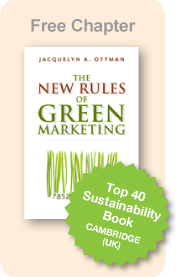Jacquie Ottman's
Green Marketing Blog
How Consumers Can Share Responsibility for Greening
July 18, 2011 by Jacquelyn Ottman
 Tom’s of Maine can make the toothpaste more natural, but they can’t force consumers to turn the water off when they brush. Coke can make the bottles recyclable, but only consumers can drop them in the blue bin. Sun Chips can make the bags compostable, but only consumers can see that they get to a composting pile instead of a trash can.
Tom’s of Maine can make the toothpaste more natural, but they can’t force consumers to turn the water off when they brush. Coke can make the bottles recyclable, but only consumers can drop them in the blue bin. Sun Chips can make the bags compostable, but only consumers can see that they get to a composting pile instead of a trash can.
Communications can fill this gap. With life cycle risks escalating over time, green marketers must now educate their consumers on how to use and dispose of their products responsibly. And empirical evidence suggests consumers are willing to listen to these messages. Use the following tested strategies to engage your consumers.
Provide feedback.
The now familiar dashboard feature on Toyota’s Prius provides real-time in¬formation on the fuel efficiency being attained by the electric motor and combustion engine. Prius owners report trying to best their previous mileage achievements on successive tries, and they even try to beat each other.
Use peer pressure.
The software company OPower provides electric utilities with software that helps provide comparative information on electricity usage. The program measures efficiency by sending customers “smiley faces” when their performance exceeds that of neighbors. This simple software was responsible for generating sustained re¬ductions of energy usage by 2% in a 2008 test by the Sacramento Municipal Utility District.
Make it fun.
Incentives and rewards can help too. RecycleBank, for one, does a fine job of educating consumers through the use of games. SmartPhones are also making new information accessible to consumers. Phone applications that check a product’s eco-credentials are becoming especially popular, turning shopping into a new educational experience
Make the intangible tangible.
Motivate consumers to use and dispose of products more re¬sponsibly by using compelling visuals to better communicate their impacts. The chart from Procter & Gamble (I added the “You are Here”) was intended for businesspeople, so it might be a tad technical, but I think you’ll get my point. It shows the energy impacts throughout various life cycle stages for several product categories, including laundry detergent, sham¬poos and diapers, among others.
If you follow the line that stands out like the Empire State Building, you’ll see that the key energy-related impact of laundry detergent is not related to the production process or supply chain transportation; the main impact is the energy it takes to heat the water. I’m sure you’ll agree that a visual like this combined with additional information-let’s say costs and climate change impacts—could be instrumental in getting consumers to turn the dial down to cold.

More information about this topic is available from my “Moving Sustainability Forward” green paper. Click here to download a copy.
Click here for a video of Jacquie presenting these ideas and more at Sustainable Brands ‘11 on June 7, 2011.
Jacquelyn Ottman is an expert adviser on green marketing to Fortune 500 companies and the U.S. government. She is the author of four books on green marketing, including the recently released The New Rules of Green Marketing: Strategies, Tools and Inspiration for Sustainable Branding (Berrett-Koehler, 2011)
Recent blog posts:
• “Running on Human Power”
• “Let the Consumer Decide ‘What is Green?’”
• “New Nissan Ads Shift the Way Car Buyers Evaluate Options”
Subscribe to “Jacquie Ottman’s Green Marketing Blog” by clicking here.
This post originally published on TriplePundit.com.



 ShareThis
ShareThis

